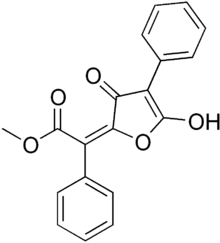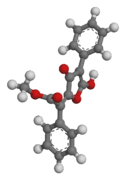Vulpinic acid
| |||
| Names | |||
|---|---|---|---|
| IUPAC name
Methyl (2E)-2-(5-hydroxy-3-oxo-4-phenylfuran-2-ylidene)-2-phenylacetate | |||
| Identifiers | |||
| 521-52-8 | |||
| ChEMBL | ChEMBL463212 | ||
| Jmol-3D images | Image | ||
| PubChem | 3033539 | ||
| |||
| Properties | |||
| Molecular formula |
C19H14O5 | ||
| Molar mass | 322.31 g·mol−1 | ||
| Except where noted otherwise, data is given for materials in their standard state (at 25 °C (77 °F), 100 kPa) | |||
| | |||
| Infobox references | |||
Vulpinic acid is a naturally occurring pulvinic acid derivative found in several lichen species, as well as some non-lichenized fungi. It was first isolated in 1925.[1] It is bright yellow, and relatively toxic.
Occurrence in lichens
Together with usnic acid and pinastric acid, vulpinic acid is secondary metabolite of the fungi. It is speculated that the substances are used as repellent for some herbivores.[2] The substance showed also some activity against gram-positive bacteria.[3]
See also
References
- ↑ Mazza, Franc Paolo (1925). "Constitution and physical properties of vulpinic acid". Rend. Accad. Sci. Napoli 31: 182–90.
- ↑ Lawrey, James D. (1989). "Lichen Secondary Compounds: Evidence for a Correspondence between Antiherbivore and Antimicrobial Function". The Bryologist (The Bryologist, Vol. 92, No. 3) 92 (3): 326–328. doi:10.2307/3243401. JSTOR 3243401.
- ↑ Bačkor, M.; Hudá, J.; Repčák, M.; Ziegler§, W.; Bačkorová, M. (1998). "The Influence of pH and Lichen Metabolites (Vulpinic Acid and (+) Usnic Acid) on the Growth of the Lichen Photobiont Trebouxia Irregularis". The Lichenologist 30 (6): 577. doi:10.1017/S0024282992000574.

